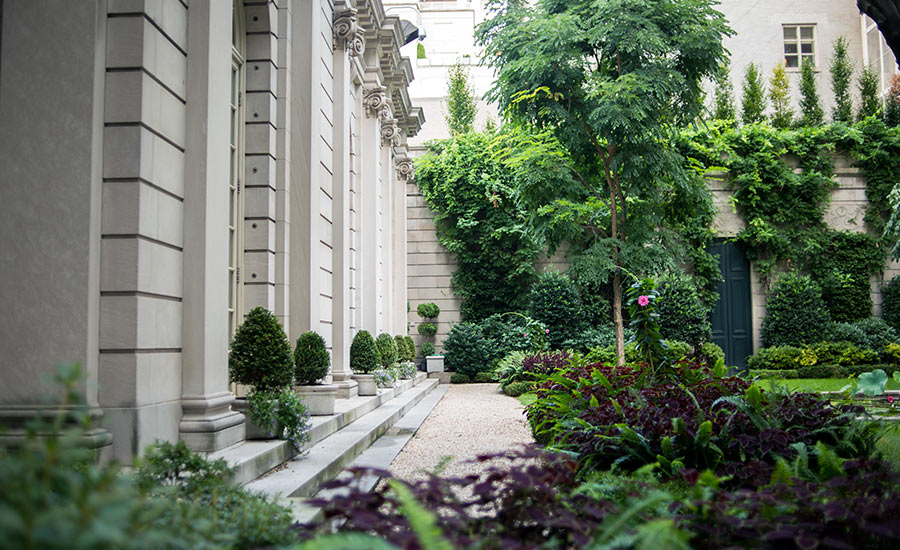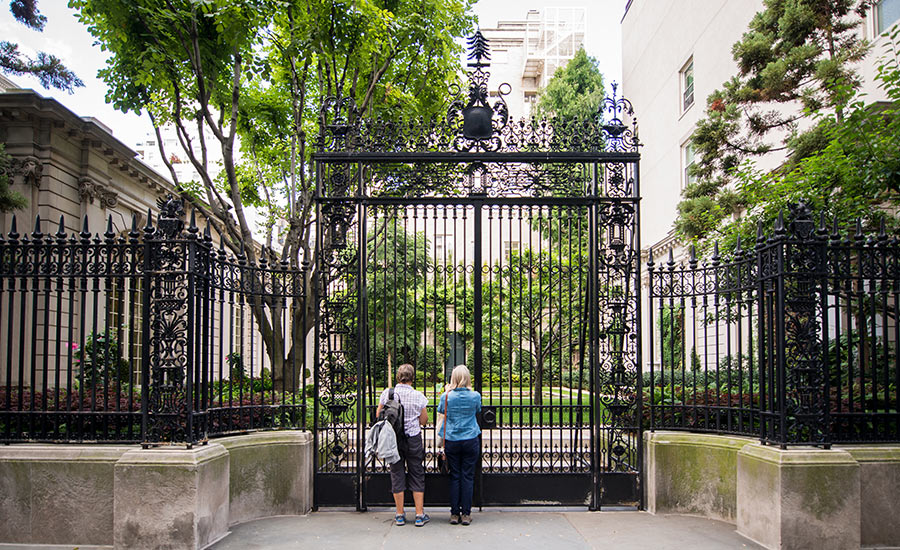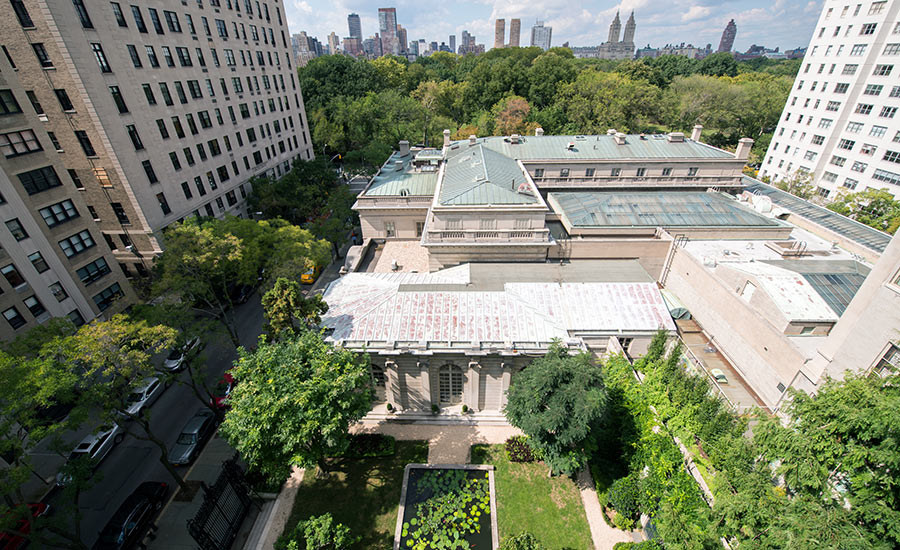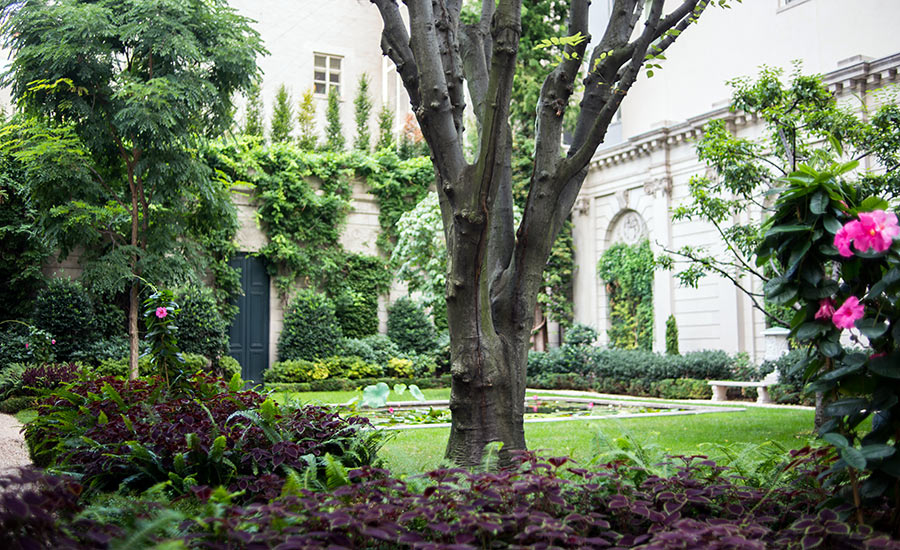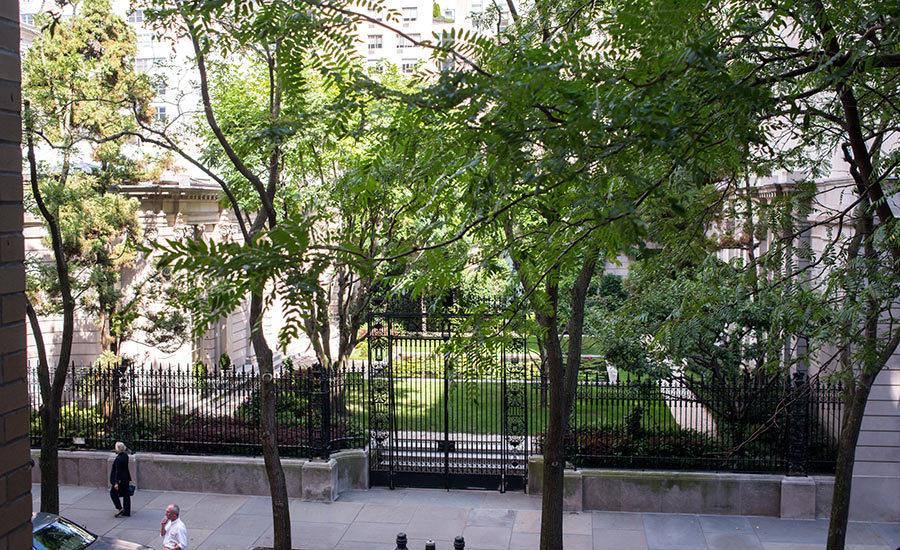“A discerning eye needs only a hint, and understatement leaves the imagination free to build its own elaborations.”
History
The Frick Collection located on New York City’s Upper East Side adjacent to Central Park, houses a collection of art by Vermeer, Rembrandt, and other famous Old Masters. The architecture firm of Carrère and Hastings designed the Beaux Arts style mansion, which was constructed in 1913-1914, for industrialist Henry Clay Frick. Following Frick’s death in 1919 and that of his wife Adelaide in 1931, the building was converted into a museum, which opened in 1935. Since then there have been some additions, including, a courtyard garden on East 70th Street designed by the pre-eminent British landscape architect Russell Page (1906-1985). Of all the projects the landscape architect had hoped to see created in New York City this is the only one realized. The New York Times obituary for Page called it one of his “most important works.”
Page, born in Lincolnshire, England, studied art at the University of London, and in Paris, before undertaking his first large-scale landscape project; a series of improvements to the expansive Capability Brown-designed gardens at Longleat House in Wiltshire. This first project launched a career working on significant commissions, many for large estates, throughout Europe, and then later, worldwide. Page completed his first commission in America in the 1950s, designing a garden for Kiluna Farm in Manhasset, Long Island, now only partially extant. His remaining U.S. commissions include a colonnaded pavilion for the United States National Arboretum in Washington, D.C., the PepsiCo Headquarters in Purchase, New York, and a private residence in Fort Worth, Texas.
The Frick commission came in 1973. The site was one of three contiguous lots adjacent to the mansion that museum officials had begun acquiring in 1940, with the intention of using the land for a future addition. The last lot, on which stood the former home of collector George Widener, along East 70th Street, was purchased in 1972; in 1973, the structure was razed, an act that generated considerable uproar. That same year, the Frick announced plans to build a temporary garden on the site, to be replaced a decade or so later by a building addition. The project proved cost-prohibitive and was abandoned; museum officials then embarked on a new project. As the Frick’s February 4, 1977 press release states: “[I]t was decided to instead reduce the size of the projected wing and to erect a small one-story pavilion and a permanent garden.” The New York City Landmarks Preservation Commission approved this plan on May 23, 1974, and the permanent garden was completed in 1977.
Page created what is known as a viewing garden, one to be looked at through the windows of the museum or from East 70th Street, rather than occupied. It’s enclosed on three sides by buildings. To the south, an iron fence and gate separates the garden from the street. The design centers on a rectangular panel of lawn edged by gravel paths, and planting beds that abut the buildings and fence. At the center of the lawn is a rectangular pool of water with a single low fountain. The flat pool, which is planted with water lilies and American lotus, creates an illusion that the space is larger than it actually is. According to Marina Schinz and Gabrielle van Zuylen in their book The Gardens of Russell Page (Frances Lincoln Ltd, 2008): “[I]n Holland, Page had noticed how water served to enlarge one’s sense of actual distance, and so he employed this optical trick at the Frick.”[1] Page planted four trees on the lawn panel, a crabapple, goldenrain tree, Kentucky yellow-wood, and a Japanese pagoda tree. In addition, a row of Callery pears is planted in a planter behind the northern wall to screen the museum’s library building which sits behind.
The Frick commission was important to Page because, as Schinz and van Zuylen say: “Toward the end of his long career Page was keenly aware that of the hundreds of gardens he had designed, many had disappeared. He hoped that the ones he was doing in the public sector might find permanence now that foundations and corporations had taken over the role of patronage from the aristocracy and the great industrialists of the nineteenth century.”[2] Paula Dietz in the book Of Gardens: Selected Essays, quotes Everett Fahy, the former Frick director who oversaw the garden’s installation in 1976-1977 as saying of Page: “He regarded this garden as his calling card.”[3]
THREAT
In June of 2014, the Frick Collection announced plans to demolish the garden to accommodate a six-story, 42,000-square-foot addition designed by Davis Brody Bond Architects and Planners. It would serve primarily as an education and research center, housing an auditorium, study room, reference library expansion, and lab, and add nominally to the museum’s current gallery space.
Museum officials have claimed the Page garden was meant to be temporary and that the space was always intended for an addition. This is a direct contradiction of the museum’s own 1977 press release, which calls the garden “permanent.” Museum officials, implying the garden is wasted space or underperforming, have also said it’s not publicly accessible. This ignores the artist’s intent – the creation of a viewing garden – and the reality that the site is used for museum events.
Most significantly, Frick officials do not treat Page’s creation as a work of art – one it commissioned, that is part of its permanent collection and worthy of the same curatorial attention as its much lauded art and architecture. This curatorial disparity is not unusual and has resulted in the destruction of important designed landscapes around the country by the otherwise esteemed cultural stewards that commissioned them. In a July 30, 2014 article criticizing the proposed addition, New York Times architecture critic Michael Kimmelman was pointed on this matter: “Great public places and works of landscape architecture deserve to be treated like great buildings.” [4]
Schinz and van Zuylen’s The Gardens of Russell Page closes on a poignant note: “All serious art is a critical act, a reconstruction as well as a criticism of life. It is also an attempt at immortality. Russell Page was as acutely conscious of this as any other creator. The ephemerality of his art, and the sadness he felt for all the gardens made and lost in his lifetime, strengthened his desire to create and to endure. The gardens he designed in the United States, especially those for the Frick Collection, the Columbus Museum of Art, and the PepsiCo sculpture park, were his final wager against the erosion of time.”[5]
1 Marina Schinz and Gabrielle van Zuylen, The Gardens of Russell Page (London: Frances Lincoln Ltd, 2008), 223.
2 Ibid, 221.
3 Paula Deitz, Of Gardens: Selected Essays (Philadelphia: University of Pennsylvania Press, 2011), 35.
4 Michael Kimmelman, “The Case Against a Mammoth Frick Collection Addition,” The New York Times, July 30, 2014.
5 Marina Schinz and Gabrielle van Zuylen, The Gardens of Russell Page (London: Frances Lincoln Ltd, 2008), 248.

